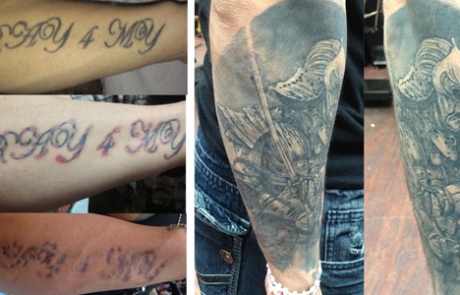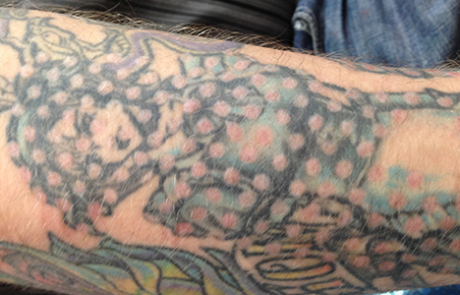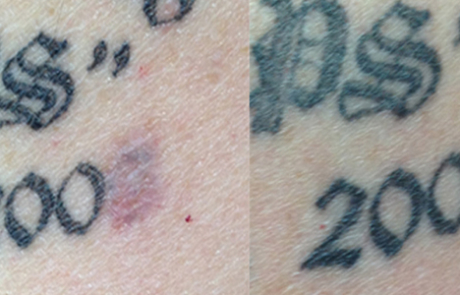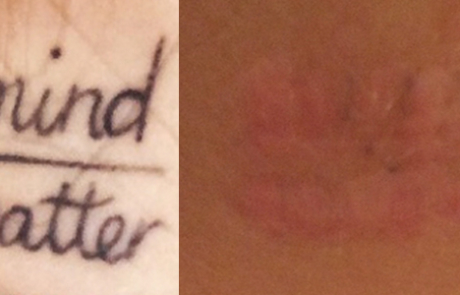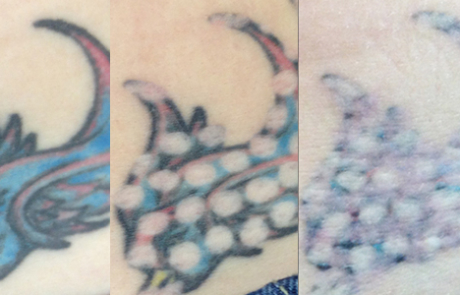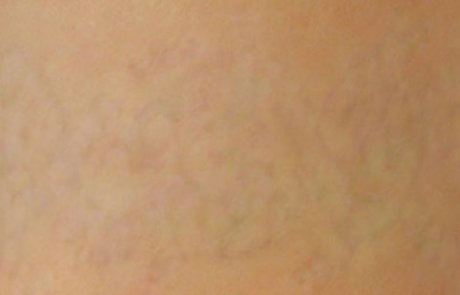Laser vs Non-Laser Tattoo Removal Process
Laser tattoo removal process utilizes pulses of light to heat up the subdermal pigment and break it into smaller particles that are carried off into the body by white blood cells. Calling laser treatment “removal” is really overstated, as it only drives ink deeper into your body, not truly removing it.
Some colors are more easily affected by laser treatment than others; the most challenging are whites, pinks, blues, yellows and purples. Colors like yellow #7 are known to break down into toxins that can find their way to the lymphatic system, lymph nodes, kidneys, liver and spleen.
“Chemists from several laboratories, including the government’s National Center for Toxicological Research, have identified low levels of carcinogens in tattoo ink. But the laser removal process, which demolishes the pigment by scorching it with heat, triggers chemical reactions that generate carcinogenic and mutation-inducing breakdown products, which are then absorbed by the body. Recently, German scientists reported that concentrations of toxic molecules from red and yellow pigments increased up to 70-fold after laser irradiation. And the bigger the tattoo, the greater the toxic release.”
– Bernadine Healy, M.D. – The Dangerous Art of the Tattoo
So what are the risks of laser removal? When you get a tattoo, the ink is injected into the dermis layer of your skin where it soaks into fibroblast skin cells and become permanent, similar to a scar. This is the reason skin art can last for a lifetime. As long as the pigment particles stay in these skin cells, they do not seem to affect the body’s health. But what happens to that ink when it’s subjected to laser treatments?
“A particle can have safe components in its chemical structure when it was injected, but when you hit it with a laser, you’ve turned it into something else – you’ve basically cooked it. You break it into smaller byproducts and it’s those byproducts that really are of concern.”
– Dr. Jeffery L. Deal, Medical Director, Rejuvatek Medical
Laser treatment has other risks as well. If not applied correctly, the heat from the laser can burn and scar the skin. Blistering, swelling, infection, and changing of the skin’s normal pigmentation are other possible side effects.
The biggest drawback to laser treatment is that is there’s no guarantee it will work. Multiple treatments will be required and the number of sessions isn’t something that can be predetermined during an initial consultation. While an average six to 10 treatments might be accurate, it’s possible that the number will be much higher depending on the design, color, and location of the tattoo and variation of skin pigmentation. Even then, many colors will still be visible.
Most laser tattoo procedures are done in a medical clinic by highly trained technicians, or by a professional dermatologist. This means that in most cases, tattoo studios can’t offer laser tattoo removal even if they wanted to.
Tatt2Away: The New Standard of Care
Tatt2Away puts tattoo removal into the hands of trained and certified tattoo artists. Unlike laser, Tatt2Away works with the body’s natural healing process to lift pigment out of the skin. The treatment uses a proprietary solution to liberate the old ink from your skin, which is drawn into a special scab and removed. When the scab is gone (10 to 21 days), so is the ink. Best of all, the process is effective on all colors of ink – it’s “colorblind.”

“With Tatt2Away, you don’t just move (ink/pigment) from the skin to other parts of your system. You actually remove the tattoo. I can’t emphasize how important that is. Besides taking a knife and actually excising the skin, Tatt2Away is the only true tattoo removal process with which I’m familiar.”
– Dr. Jeffery L. Deal
The advantage of Tatt2Away compared to laser methods are many. For the studio owner, it is another related service they can offer that will enhance the quality of their work. For clients seeking tattoo removal, Tatt2Away means less of an investment in time and money, less pain, proven and visible results, all of which adds up to a more satisfactory outcome.
A Better Way to Revise Your Body Art
As Tatt2Away can target specific sections of a tattoo using a process called Tatt2Revise, it is the perfect alternative to a traditional coverup.
Until now, the rule of thumb with coverups was larger and darker – to successfully mask the old ink, the new work had to cover a larger area and use heavier, darker color. Being able to break up the pattern of the old ink, essentially drawing the eye away from the existing tattoo, means a coverup isn’t limited to size, placement and color. Even with tribal tattoos done with black pigment, just a few Tatt2Away treatments may be adequate to rejuvenate enough skin so that the new design doesn’t have to be denser than the one underneath.
Learn more about the coverup alternative and the Tatt2Revise process
Script for Samurai Cover Up
Tattoo Pattern Disruption for DEScoverup: Treatment Completed
Blue Maid Tattoo Cover Up
This was a tattoo done over 10 years ago, when the client was a teenager. He is getting it removed in order to get better work from artists he admires.
Tattoo Corrections
Correction: Sometimes our memories fail us! We had a client remember a date wrong, only for his wife to alert him to the fact when he went home
Mind Over Matter Tattoo
This client was removing her tattoo to enlist in the military - this is only a month out from the removal!
Swallows Tattoo
This client liked the idea of the tattoo, but not how it was executed.
12 Month Removal
With Tatt2Away, scarring is marginal as is any residual look of a previous tattoo.




